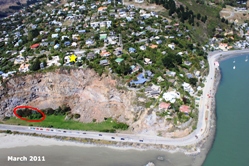
HERE WE GO AGAIN
On 13 June at 1300, a magnitude 5.5 struck. The shaking was significant enough for a few things to fall over in the office and for us to head out and do a quick check on the main lifelines - where nothing too major seemed to have occurred, other than a large tension crack in the cliff above the main road. I had just arranged to get half the road closed and the traffic clear before 1400 when a magnitude 6.3 struck, this time with a PGA of 2.13g. This time the epicentre was located on the coast to the east of the city, just a few meters from where I was standing, at the base of a 75m high cliff. A huge collapse occurred, as several thousand cubic metres of rock - 15 horizontal metres of the cliff top - fell down, together with half a house. That was the fastest I ever expect to have to run, in my life.
Caption : Peacock’s Gallop Cliff after the February and June earthquakes - before & after (second image below)
Hearts across the city sank as a combined groan of "here we go again" went up. Our daily geotechnical morning meetings recommenced (we had dropped them back to twice a week) and we had to re-inspect the whole of the Port Hills area again.
From a rockfall perspective, the June earthquake was more damaging than the February one in the eastern part of the Port Hills. Tens more houses had to be evacuated due to new cracking, generally at cliff-top settings. More rockfall was observed, and some boulders that had not moved previously were now at a high risk of imminent failure. The landslide that I had initially monitored in February moved another 500mm or so, and new cracking opened in new areas leading to a growing concern of new landslides developing.
The June earthquake set us back a long way in our attempts to remediate rockfall in the hills. Following the earthquake all boulders across the hills were re-mapped and evaluated. In some areas where remediation had been completed no further rockfall was observed. This was some much-needed morale-boosting news! Rockfall that did occur was, in places, very directional - in that the June fault-line was oriented approximately north-south. In one valley close to the epicentre, there was very little new rockfall on north-western slopes but over 200 additional boulders on eastern slopes. The predominant shaking was northwards; so on the north-western slopes, boulders were ‘pushed’ into the hillside while on the south-eastern slopes they were ‘pushed’ out.